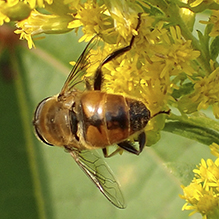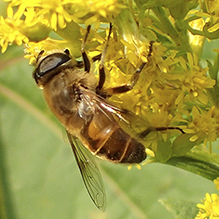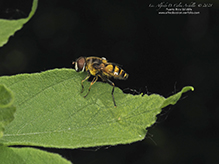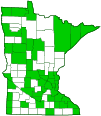common drone fly
(Eristalis tenax)
Conservation • Description • Habitat • Ecology • Distribution • Taxonomy
Conservation Status |
|
|||||||
| IUCN Red List | not listed |
|||||||
| NatureServe | NNA - Not applicable |
|||||||
| Minnesota | not listed |
|||||||
Description |
||
Common drone fly is a large, exotic, migratory, cosmopolitan, drone fly. It is native to Europe and Asia. It has been widely introduced and now occurs worldwide on every continent except Antarctica. It has been recorded in the United States in every state except Mississippi and Louisiana but including Alaska and Hawaii, and in every Canadian province except Nunavut. It is common in Minnesota. The adult is ½″ to ⅝″ (11.7 to 15.8 mm) in length. It is similar in shape, appearance, and behavior (Batesian mimicry) to the western honey bee (Apis melifera). The body is robust and hairy. The head is wider than high and is as broad or slightly broader than the thorax. There are two large compound eyes on the sides of the head and three small simple eyes (ocelli) in a triangle on top of the head. The compound eyes are uniformly dark brown, without colored bands or spots. They are densely covered with short erect hairs and have two broad vertical bands of long erect hairs that are more dense than the short hairs. On the male the compound eyes meet at the top of the head. On the female they do not. The forehead (frons) is black in the middle with a broad pale yellow stripe on each side. The face is slightly projected diagonally forward and downward. It is pale yellow except for a black stripe in the middle that extends all the way to the lower margin. The protruding mouthpart (proboscis) is short and fleshy. The antennae are short, have three segments, and are inserted near the middle of the head. The third antennal segment is long on the upper side, short and rounded on the underside. It has a long, stiff, forward-pointing bristle (arista) above. The arista is feather-like (plumose) at the base. There is no line-like groove (suture) extending downward from the base of each antenna. The thorax is black, short, and somewhat convex when viewed from the side. It is moderately or densely covered with long, more or less erect, brownish-yellow hairs. The hairs are not dense enough to obscure the ground color, so that when viewed from directly above, the thorax appears black. On each side of the thorax, in the shoulder (humeral) area just behind the head, there is a small plate (postpronotum). The postpronotum is hairy. The small rear part of the thorax (scutellum) is more or less translucent with a variable amount of yellow tinting. It does not have a fringe of hairs. The abdomen is black with variable orange or yellowish-orange markings. The first segment is very short and is covered with long hairs. The remaining segments are moderately covered with hairs. The second segment has a pair of large spots that narrow toward but do not meet in the middle, and a narrow band on the rear margin. The third segment is shiny and has a variable amount of orange. Generally, it has a narrow orange band on the front and rear margins, and a pair of stripes on each side that sometimes merge together but do not reach the opposite pair in the middle. Sometimes these markings are very faint and the third segment appears entirely black. The fourth segment may have a pair of large spots or be entirely black. The wings are usually clear. There is sometimes a diffuse brown cloud near the middle, but it is never a well-defined, squarish spot. There is a false (spurious) vein between the radius (R) and media (M) veins and parallel to them. It is not a true vein but rather a streak of discoloration. The radial sector (Rs) vein has two branches. The R4+5 vein is deeply bent (sinuous), appearing “bumped” downward in the middle. The anal cell is long and is closed near the wing margin. Cell R2+3 is closed before the wing margin. The marginal, R1, and M2 cells are also closed. The legs are black and yellow. The third segment (femur) on the hind leg is moderately thickened and has no spurs, spines, or teeth. The fourth segment (tibia) on all legs is straight or moderately curved. On the hind legs the tibia is entirely dark brown or black. |
||
Size |
||
½″ to ⅝″ (11.7 to 15.8 mm) |
||
Similar Species |
||
Habitat |
||
|
||
Ecology |
||
Season |
||
Early July through early November in Minnesota, year round in the south. |
||
Behavior |
||
Larvae have a long, tail-like extension of the body (siphon). As they swim through the water searching for food the tip of the siphon remains at the water surface, allowing them to breathe air. Groups of females have been observed hibernating in crevices and holes in the sandstone caves near St. Paul. After migrating, individual males disperse, establish a territory, and fiercely defend it. |
||
Life Cycle |
||
Females hibernate in protected areas, but males do not survive the winter. Masses of eggs are laid in small ponds, ditches, drains, and manure lagoons, near the surface of water with high levels of organic matter. Adults emerge in Minnesota beginning in early July. A new generation migrates north in the summer. |
||
Larva Food |
||
|
||
Adult Food |
||
Flower nectar |
||
Distribution |
||||
|
Sources Telford, Horace S.. (1939). The Syrphidae of Minnesota. University of Minnesota. Minnesota Agricultural Experiment Station. |
|||
| 12/13/2022 | ||||
Occurrence |
||||
very common and very widespread |
||||
Taxonomy |
|||
Order |
Diptera (Flies) | ||
Suborder |
Brachycera | ||
Infraorder |
Cyclorrhapha | ||
| Zoosection | Aschiza | ||
Family |
Syrphidae (Hover Flies) | ||
Subfamily |
Eristalinae (Drone Flies and Allies) | ||
Tribe |
Eristalini (Rat-tail Maggot Flies) | ||
| Subtribe | Eristalina | ||
Genus |
Eristalis (drone flies) | ||
| Subgenus | Eristalis | ||
Synonyms |
|||
Eristalis campestris Musca tenax |
|||
Common Names |
|||
common drone fly drone fly rat-tailed maggot (larvae) |
|||
Glossary
Arista
A large bristle on the upper side of the third segment of the antenna of a fly. Plural: aristae.
Femur
On insects and arachnids, the third, largest, most robust segment of the leg, coming immediately before the tibia. On humans, the thigh bone.
Frons
The upper front part of an insect’s face, roughly corresponding to the forehead.
Ocellus
Simple eye; an eye with a single lens. Plural: ocelli.
Proboscis
The tube-like protruding mouthpart(s) of a sucking insect.
Scutellum
The exoskeletal plate covering the rearward (posterior) part of the middle segment of the thorax in some insects. In Coleoptera, Hemiptera, and Homoptera, the dorsal, often triangular plate behind the pronotum and between the bases of the front wings. In Diptera, the exoskeletal plate between the abdomen and the thorax.
Tarsus
On insects, the last two to five subdivisions of the leg, attached to the tibia; the foot. On spiders, the last segment of the leg. Plural: tarsi.
Tibia
The fourth segment of an insect leg, after the femur and before the tarsus (foot). The fifth segment of a spider leg or palp. Plural: tibiae.
Visitor Photos |
|||||
Share your photo of this insect. |
|||||
| This button not working for you? Simply email us at info@MinnesotaSeasons.com. Attach one or more photos and, if you like, a caption. |
|||||
Babette Kis |
|||||
Eristalis tenax (common drone fly) |
|||||
 |
 |
||||
 |
|||||
Alfredo Colon |
|||||
 |
|||||
MinnesotaSeasons.com Photos |
|||||
|
|||||

Slideshows |
||

Visitor Videos |
|||
Share your video of this insect. |
|||
| This button not working for you? Simply email us at info@MinnesotaSeasons.com. Attach a video, a YouTube link, or a cloud storage link. |
|||
Other Videos |
|||
| Eristalis tenax Jorge Iriberri |
|||
About
Dec 1, 2019 Imágenes e información sobre una especie de insectos |
|||
| Drone Fly Buzzing Me - Eristalis pertinax - Zweefvlieg in Dutch pijnacker01 |
|||
About
Apr 21, 2016 Drone Fly Buzzing Me - Eristalis pertinax - Zweefvlieg in Dutch. "Eristalis pertinax is a European hoverfly." see - https://en.wikipedia.org/wiki/Eristal... I made friends with what I thought was a wasp or bee, but a special hoverfly or fly! Now you know were drones got their name from, this fly! He can hover like the best and landed on my hand a lot. Drone Fly in action! |
|||
| Drone fly (Eristalis tenax) Honey bee mimic Ro EB |
|||
About
Jun 24, 2016 This drone fly or flower fly was on a sunflower next to honey bees, very good imposter, mimic bee. Hoverflies, sometimes called flower flies, or syrphid flies, make up the insect family Syrphidae. |
|||

Created: 12/13/2022
Last Updated:


